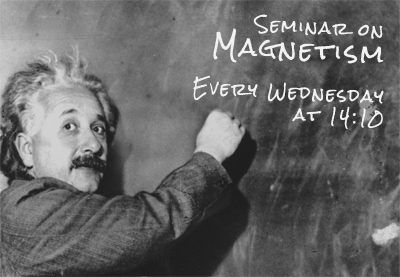Seminar on Magnetism
Group of Magnetism at the Department of Condensed Matter Physics
of Charles University and MGML has a pleasure to invite you to attend the joint seminar
on 25th September 2024 at 14:10
at Faculty of Mathematics and Physics of Charles University, Ke Karlovu 5, 121 16 Praha 2
Lecture room F2
Elsa Lhotel
Institut Néel, CNRS & UGA, 25 rue des Martyrs, 38042 Grenoble, France
Magnetic fragmentation in pyrochlore iridates and ruthenates
Elsa Lhotel » Magnetic fragmentation in pyrochlore iridates and ruthenates
Institut Néel, CNRS & UGA, 25 rue des Martyrs, 38042 Grenoble, France
Online link: cesnet.zoom.us Ask R. Colman for password.
Location: Lecture room F2, Ke Karlovu 5, at 14:10.
E. Lhotel 1, F. Museur1,2, F. Morineau1, E. Lefrançois1,3, V. Cathelin1, J. Robert1, R. Ballou1, P.C.W. Holdsworth2 and V. Simonet1
1 Institut Néel, CNRS & UGA, 25 rue des Martyrs, 38042 Grenoble, France
2 Laboratoire de Physique, ENS de Lyon, 69342 Lyon, France
3 Institut Laue Langevin, 38042 Grenoble, France
Among the original magnetic states which emerge from frustrated magnetic systems, spin ice has aroused a strong interest because its macroscopically degenerate ground state belongs the class of Coulomb phases: its organising principle is dictated by a local constraint called the ice-rule, which can be interpreted as a divergence free condition of an emergent gauge field. Magnetic excitations in spin ice, called magnetic monopoles, correspond to a violation of the local ice-rule and introduce a non-zero divergence in the emergent field.
Recently, theoreticians introduced the concept of magnetic moment fragmentation, whereby the local magnetic moment field fragments into the sum of two parts, a divergence full and a divergence free part. A prominent example of fragmentation occurs in spin ice, if the monopoles organise as a crystal of alternating magnetic charges. In that case, the fragmentation leads to the superposition of an ordered configuration and of an emergent Coulomb phase.
Experimentally, the fragmentation manifests itself via the superposition of magnetic Bragg peaks, characteristic of the ordered phase, and a pinch point pattern, characteristic of the Coulomb phase.
In this talk, I will show how this magnetic fragmented state can be stabilized in pyrochlore iridates R2Ir2O7, with R=Ho, Dy [1,2]. Then I will present a novel type of fragmented state that we recently discovered in in Ho2Ru2O7. Those phases could be identified thanks to powder neutron diffraction as well as thermodynamic measurements (specific heat, magnetization), down to very low
temperature (50mK).
References:
[1] E. Lefrançois et al., Nature Commun. 8 (2017), 209.
[2] V. Cathelin et al., Phys. Rev. Research 2 (2020), 032073(R).


